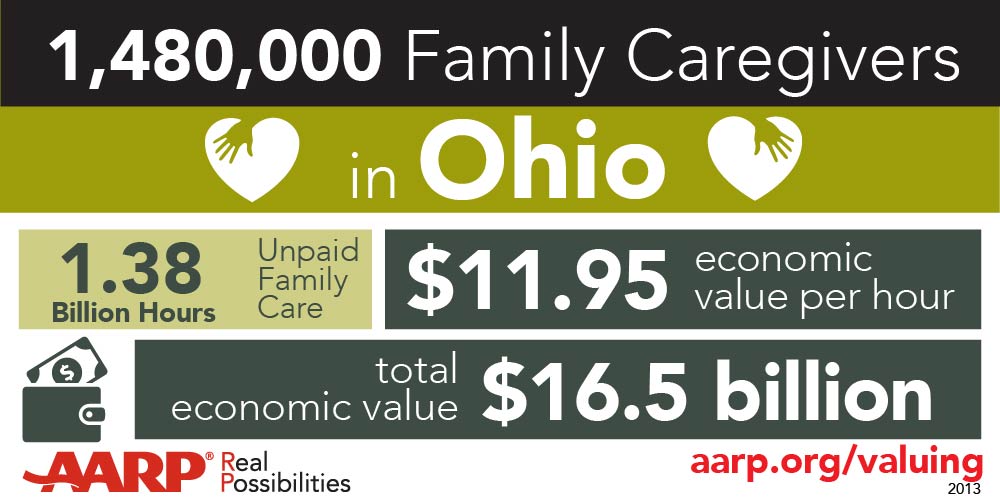AARP Hearing Center

Family caregivers in Ohio provided 1,380,000 hours of care — worth an estimated $16.5 Million — to their parents, spouses, partners, and other adult loved ones in 2013, according to AARP Public Policy Institute’s new report, Valuing the Invaluable: 2015 Update. The total estimated economic value of uncompensated care provided by the nation’s family caregivers surpassed total Medicaid spending ($449 billion), and nearly equaled the annual sales ($469 billion) of the four largest U.S. tech companies combined (Apple, Hewlett Packard, IBM, and Microsoft) in 2013.
Family caregiving for relatives or close friends with chronic, disabling, or serious health problems so they can remain in their home is nearly universal today. In 2013, about 1,480,000 family caregivers in Ohio helped another adult loved one carry out daily activities (such as bathing or dressing, preparing meals, administering medications, driving to doctor visits, and paying bills).
“This report shows just how very important it is that we show our support for all of these Ohioans who are helping their parents, grandparents, spouses or other adult loved ones to remain living in their own homes,” said Trey Addison with AARP Ohio. “We need to adopt an Ohio Caregiver Act that will make it easier for caregivers to coordinate care when a loved one is admitted to or released from a hospital or rehabilitation facility.”
Family Caregivers in the Future
As Americans live longer and have fewer children, fewer family members will be available for older adults to rely on for everyday help in the future. The ratio of potential family caregivers to the growing number of older people has already begun a steep decline. In 2010, there were 7.2 potential family caregivers for every person age 80 and older. By 2030, that ratio will fall sharply to 4 to 1, and is projected to drop further to 3 to 1 in 2050.
Impact of Caregiving on Jobs, Money, and Health
Family caregivers report that the stress of caregiving affects their physical and emotional health, finances, and their jobs.
- More than half (55%) of family caregivers report being overwhelmed by the amount of care their family member needs.
- Nearly 4 in 10 (38%) family caregivers report a moderate (20%) to high degree (18%) of financial strain as a result of providing care.
- In 2014, the majority (60%) of family caregivers had full- or part-time jobs.
Caregiving Resources:
- AARP Caregiving Resource Center
- Caregiving in the US: 2015 Report
- Home Alone: Family Caregivers Providing Complex Chronic Care (October 2012)
- The ABA/AARP Checklist for Family Caregivers: A Guide to Making It Manageable (2015)
- Amy Goyer’s ABA/AARP Juggling Life, Work and Caregiving (2015)
- AARP’s I Heart Caregivers Initiative































































